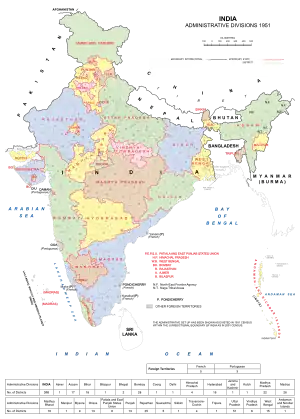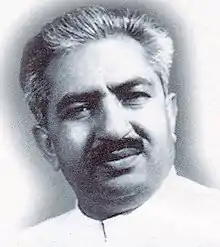| ||||||||||||||||||||||||||||
All 48 seats to the Delhi Legislative Assembly 25 seats needed for a majority | ||||||||||||||||||||||||||||
|---|---|---|---|---|---|---|---|---|---|---|---|---|---|---|---|---|---|---|---|---|---|---|---|---|---|---|---|---|
| ||||||||||||||||||||||||||||
| ||||||||||||||||||||||||||||

The first Delhi Legislative Assembly election to the Delhi Legislative Assembly was held on 27 March 1952.[1][2] Forty-eight seats were up for election.[2] Six of the constituencies elected two assembly members, the remaining 36 constituencies elected a single member.[1]
Results
Congress emerged as the single largest party in the first legislative elections held in Delhi.[1] Chaudhary Brahm Prakash of Indian National Congress was elected Chief Minister.
 | |||||||||
|---|---|---|---|---|---|---|---|---|---|
| Party | Seats Contested | Won | % of Seats | Votes | Vote % | ||||
| Indian National Congress | 47 | 39 | 81.25 | 2,71,812 | 52.09 | ||||
| Bharatiya Jana Sangh | 31 | 5 | 10.42 | 1,14,207 | 21.89 | ||||
| Socialist Party | 6 | 2 | 4.17 | 12,396 | 2.38 | ||||
| Akhil Bharatiya Hindu Mahasabha | 5 | 1 | 2.08 | 6,891 | 1.32 | ||||
| Independent | 78 | 1 | 2.08 | 82,972 | 15.90 | ||||
| Total Seats | 48 | Voters | 7,44,668 | Turnout | 5,21,766 (58.52%) | ||||
Elected members
| S.No. | Constituency | Member | Party | |
|---|---|---|---|---|
| 1 | Kotla Feroze Shah | Shanta Vasisht | Indian National Congress | |
| 2 | Parliament Street | Kaushaleshwar Prasad Shankara | Indian National Congress | |
| 3 | Safdar Jang | Daljit Singh | Indian National Congress | |
| 4 | Lodhi Road | Shiva Nandan Rishi | Indian National Congress | |
| 5 | Puran Qilla Viney Nagar | Pushpa Devi | Indian National Congress | |
| 6 | Delhi Cantt | Raghvendra Singh | Indian National Congress | |
| 7 | Reading Road | Amin Chand | Bharatiya Jana Sangh | |
| 8 | Prafulla Ranjan Chakravarty | Indian National Congress | ||
| 9 | Chittar Gupta | Kartar Singh | Indian National Congress | |
| 10 | Mantola | Mushtaq Rai | Indian National Congress | |
| 11 | Ram Nagar | Shankar Lal | Indian National Congress | |
| 12 | Jhanday Walan | Ghardhari Lal Salwan | Bharatiya Jana Sangh | |
| 13 | Kashmere Gate | Bhagwan Dass | Indian National Congress | |
| 14 | Chandni Chowk | Yudhvir Singh | Indian National Congress | |
| 15 | Phatak Habash Khan | Harkishan Lal | Indian National Congress | |
| 16 | Maliwara | Anand Raj | Indian National Congress | |
| 17 | Ballimaran | Sultan Yar Khan | Indian National Congress | |
| 18 | Chawri Bazar | Nuruddin Ahmad | Indian National Congress | |
| 19 | Ajmeri Gate | Shafiq Ur Rehman Kidwai | Indian National Congress | |
| 20 | Sita Ram Bazar Turkman Gate | Shiv Charan Dass | Indian National Congress | |
| 21 | Sudershan Singh | Indian National Congress | ||
| 22 | Kucha Chelan | Mushtaq Ahmad | Socialist Party | |
| 23 | Darya Ganj | Gurmukh Nihal Singh | Indian National Congress | |
| 24 | Chandrawal | Hukam Singh | Indian National Congress | |
| 25 | Roshanara | Jagan Nath | Indian National Congress | |
| 26 | Arya Pura | Mangal Dass | Indian National Congress | |
| 27 | Tokriwalan | Gopinath | Indian National Congress | |
| 28 | Deputy Ganj | Sham Charan | Bharatiya Jana Sangh | |
| 29 | Pahari Dhiraj Basti Jullahan | Hem Chand Jain | Indian National Congress | |
| 30 | Dhanpat Rai | Indian National Congress | ||
| 31 | Manak Pura | B.D. Joshi | Socialist Party | |
| 32 | Tibbia College | Ram Singh | Akhil Bharatiya Hindu Mahasabha | |
| 33 | Naiwala | Dilawar Singh | Bharatiya Jana Sangh | |
| 34 | Rehgar Pura Dev Nagar | Daya Ram | Indian National Congress | |
| 35 | Sushila Nayar | Indian National Congress | ||
| 36 | Kishan Ganj Anad Parbat | Jag Pravesh Chandra | Indian National Congress | |
| 37 | Civil Lines | Krishna | Indian National Congress | |
| 38 | Kingsway Camp | Jang bahadur Singh | Bharatiya Jana Sangh | |
| 39 | Wazirabad | Fateh Singh | Indian National Congress | |
| 40 | Shahdara | Chinta Mani | Indian National Congress | |
| 41 | Narela | Mange Ram | Indian National Congress | |
| 42 | Prabhu Dayal | Indian National Congress | ||
| 43 | Nangloi | Chaudhary Brahm Prakash | Indian National Congress | |
| 44 | Khanjhawla | Bhup Singh | Independent | |
| 45 | Isa Pur | Subedat Hati Singh | Indian National Congress | |
| 46 | Najaf Garh | Ajit Singh | Indian National Congress | |
| 47 | Mehrauli | Mitter Sen | Indian National Congress | |
| 48 | Sukh Dev | Indian National Congress | ||
State Reorganization
On 1 November 1956, under States Reorganisation Act, 1956, Delhi was made a Union Territory under the direct administration of the President of India and the Delhi Legislative Assembly was abolished simultaneously.[3] Next legislative assembly elections in Delhi were held in 1993, when Union Territory of Delhi was formally declared as National Capital Territory of Delhi by the Sixty-ninth Amendment to the Indian constitution.[4]
See also
References
- 1 2 3 4 "Statistical Report on General Election, 1951 : To the Legislative Assembly of Delhi" (PDF). Election Commission of India. Retrieved 11 March 2014.
- 1 2 Kaushik, S. L.; Rama Patnayak (1995). Modern Governments and Political Systems. Vol. 3. New Delhi: Mittal Publications. p. 65.
- ↑ "Reorganisation of States, 1955" (PDF). The Economic Weekly. 15 October 1955. Retrieved 25 July 2015.
- ↑ "Sixty-ninth amendment". Delhi Assembly official website. Archived from the original on 21 August 2016.
